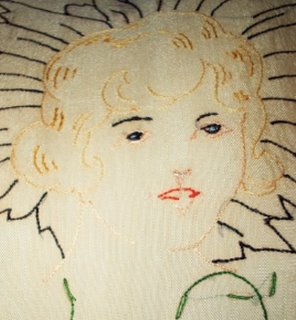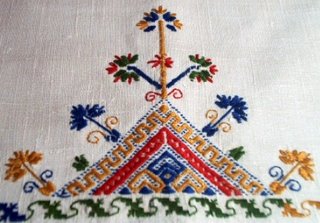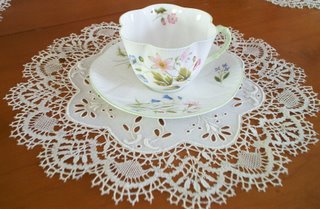A pale-almost-petal-pink silk with delicate handwork.
 This is a close up of her face
This is a close up of her faceyou can see the only flaw
beneath her nose and onto her lips.
I am of the opinion that it does not detract from her loveliness.
 A heavy linen laundry bag with a draw string
A heavy linen laundry bag with a draw string
on which someone lovingly embroidered
the floral design and the word "Laundry".
These women seemed to like naming their things!
 This textile is probably early bark cloth
This textile is probably early bark cloth
about 24 inches wide by 36 inches long.
A pocket at the top is to insert tubular cardboard.
I don't know what it was called but it was used to store linens
which were laid upon it and rolled up.
A ribbon at the top was tied to secure the package.
Linen is a brittle fiber;
folding for long periods causes the fibers to break.
Knowledgeable housewifes of the 19th and 20th centuries
devised ways to protect their precious commodities.
 Here is a closeup of one block of an early 20th century quilt.
Here is a closeup of one block of an early 20th century quilt.
Entirely hand-pieced and hand-quilted.
 This is one of a set of tea towels for each day of the week.
This is one of a set of tea towels for each day of the week.
The scene is a common depiction in the first half of the 20th century.
 This is a piece of ethnic embroidery on linen.
This is a piece of ethnic embroidery on linen.
It is probably European and has an art deco feel to me.
 I love this linen and lace tea time placemat
I love this linen and lace tea time placemat heavily padded satin stitch, richelieu cutwork
handmade lace
one of a large set.
These pieces did not come to me in pristine condition.
With few exceptions they were soiled, stained, musty and dusty.
I soak each piece in sodium perborate that I purchase thru a chemical shop on-line
sometimes for days
before drying and ironing
(no never in the dryer!).
Sometimes a piece falls apart in the bath
but mostly they come clean, sparkling, fresh
and ready to grace another table, bed or whatever.
I cherish hand-embroidered Madeira sheets and pillowcases from Portugal
an Edwardian-era silk cape for a child.
Two that did come to me in "as new" condition:
a banquet cloth with elaborate cutwork
of dancing women, musicians and 24 matching napkins in 2 sizes
&
a silk damask lined bedspread that is sooooo beautiful.
And on and on.....
Working with antique linens is a labor of love and a patient rescue operation.
It is impossible to do it without a deep respect for the textile,
its history and graceful design and the woman/women who executed it.


2 comments:
these are beautiful pat! i have bags of things from my mothers past and one huge crocheted bedspread made out of butcher string from my father's polish mother.
it weighs so much that you might stop breathing if you slept under it.
am thinking of what to do with these things...
I am always on-the-hunt: scouring auctions and estate sales. I've discovered that I love the social histories behind the work as much as the work itself ~~ the lace makers in Europe; the mill workers here; the linen weavers in Ireland. Such hardship and deprivation.
Post a Comment